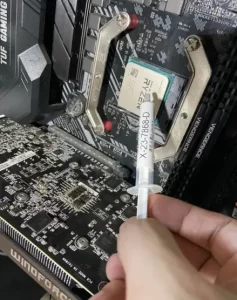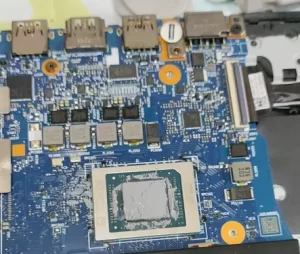Overheating is a common issue faced by CPUs worldwide. Thermal paste is one of the options used to fix overheating. But thermal paste can fix overheating only if a lack or fault of thermal paste causes the heating.
Overheating in the CPU can be due to numerous reasons. Thermal paste cannot be considered the solution for all these issues. You must identify the root cause of overheating and find a solution accordingly.
CPU Overheating Fix

CPU overheating can damage the functioning of the entire system.
CPU Overheating: Reasons
1. Heavy Workload
Using the CPU for multiple tasks simultaneously can increase its workload. This can cause the CPU to heat up beyond control. Gaming and rendering are some of the most heat-generating tasks.
2. Malware and Pending Updates
Malware is a significant threat to the stability of the CPU. It can cause the CPU heat to increase uncontrollably. Likewise, if you have any pending updates on your system, it can cause the CPU to increase its temperature and shut the system down eventually.
3. Limited Airflow
Not having proper ventilation features can make it difficult for the CPU’s cooler fans and heat sink to work effectively. This leads to the build-up of excess heat.
4. Poor Application of Thermal Paste
Thermal paste is essential to effectively transfer excess heat from the heat sink of the CPU. If there is insufficient thermal paste in the CPU, it can minimize the heat transfer and cause high temperature inside.
CPU Overheating: Solutions
Here are some practical solutions to CPU overheating.
- You have to close all the heavy-load programs immediately. Closing intensive tasks can often reduce the CPU temperature by about 60%.
- Find ways to improve airflow inside the CPU.
- Check the vents and fans of the system for any damages. If any, make sure to replace them quickly.
- Do a quick scan for malware.
- Avoid overclocking the CPU.
- Update the system if there are any pending ones.
- If you have an old CPU cooler, replace it with a new one.
- Check the heat sink of the CPU and apply thermal paste if necessary.
You may also like: Fix: CPU Overheating
What Does Thermal Paste Do?
Thermal paste is a compound that helps heat transfer from a CPU’s heatsink. The CPU’s inside surfaces can have many microscopic pores. When air enters these pores, it acts as an insulator and prevents effective heat transfer.
When you apply a thermal past into the CPU, it spreads evenly over the pores and eliminates any excess air. Thermal paste has excellent heat conductivity. So, it improves the heat transfer from the heat sink.
Thermal paste plays a significant role in controlling the inside temperature of a CPU. But overapplying it can be a problem, too.
How Much Thermal Paste on CPU?
Experts recommend applying only enough amount of thermal paste to cover the surface of the CPU IHS’ surface in a thin coat. Using too much thermal paste that can cause spillage through the sides of the HIS is not advisable.
However, the amount of thermal paste to be applied can vary significantly depending on the size of the IHS, the thermal paste type, etc.
The following are the significant features you must consider before deciding the amount of thermal paste to apply.
- Thermal conductivity of the paste
- Type of the paste (Silicon, Ceramic, or Carbon-based thermal paste)
- Quality of the thermal paste.
- Size of the IHS
Is Too Much Thermal Paste Bad?

Applying too much thermal paste is considered bad for the normal cooling process of a CPU.
Thermal paste is only a solution for the problem of air entering the pores of the IHS surface. This does not mean applying too much thermal paste can boost the cooling process.
In fact, the interaction between the IHS and the heat sink is the most effective regarding heat transfer. The metal surface of these parts enables a great heat transfer. But the air inside the pores is the only issue that happens in between. Thermal paste is only supposed to address this aspect of the cooling process.
So, applying a thin layer of the thermal paste is always ideal to even out the pores on the IHS and the heat sink. When you apply excess thermal paste, it can cause uneven heating inside the system.
Also, the excess amount of thermal paste can spill out to the system’s motherboard and damage it. Some thermal pastes have electrical conductivity, so spillage can cause short circuits and other significant damages.
You may also like: How Much Thermal Paste For My Gaming Laptop’s CPU or GPU?
How Long Does Thermal Paste Last?
On average, thermal paste can last on various devices for at least two years and a maximum of four years. But there are instances where the thermal paste has lasted for about ten years.
Several factors influence the lifespan of a thermal paste. Some of those critical factors are as follows.
- System usage intensity
- Surrounding climate
- Quality of the thermal compound
- Amount of dust build-up
Can Old Thermal Paste Cause Overheating?
Old thermal paste often gets criticism for causing overheating. When you use a thermal paste for a long time, the CPU heat will gradually dry it. The thermal paste starts degrading once it is dried.
So, an old or dried thermal paste starts performing poorly regarding heat transfer. Thus, it is advisable to replace old thermal paste as it can cause severe overheating.
You may also like: Can Thermal Paste Harm the Processor?
How Often Should You Replace A Thermal Paste on a CPU?
It would be best to replace the CPU’s thermal paste whenever you find it oddly overheating. It is advisable to clean the thermal paste first before replacing it. Sometimes, a mild cleaning can improve the efficiency of the thermal paste.
If cleaning is not so effective, it means that it is time to replace the thermal paste. You can remove the old thermal paste carefully and then give the chip a fresh coat of the paste.
You may also like: Can 99% Isopropyl Alcohol Safely Clean CPU Thermal Paste?
Can New Thermal Paste Improve Performance?
Applying a new coat of thermal paste can often improve the heat transfer inside the CPU. It does not improve the other general functions of a system. Thermal paste is only related to heat transfer. A new thermal paste boosts the cooling process inside the CPU.
In terms of performance, thermal paste cannot improve the speed or efficiency of the system. But applying a fresh coat can always prevent slowdowns. So, indirectly, it enhances the performance.
Conclusion
Applying an even coat of new thermal paste reduces the system temperature by about three degrees. Replacing old thermal paste with a fresh coat can work wonders inside the CPU. However, applying only a pea-sized amount is advisable to avoid spillages and short circuits.
